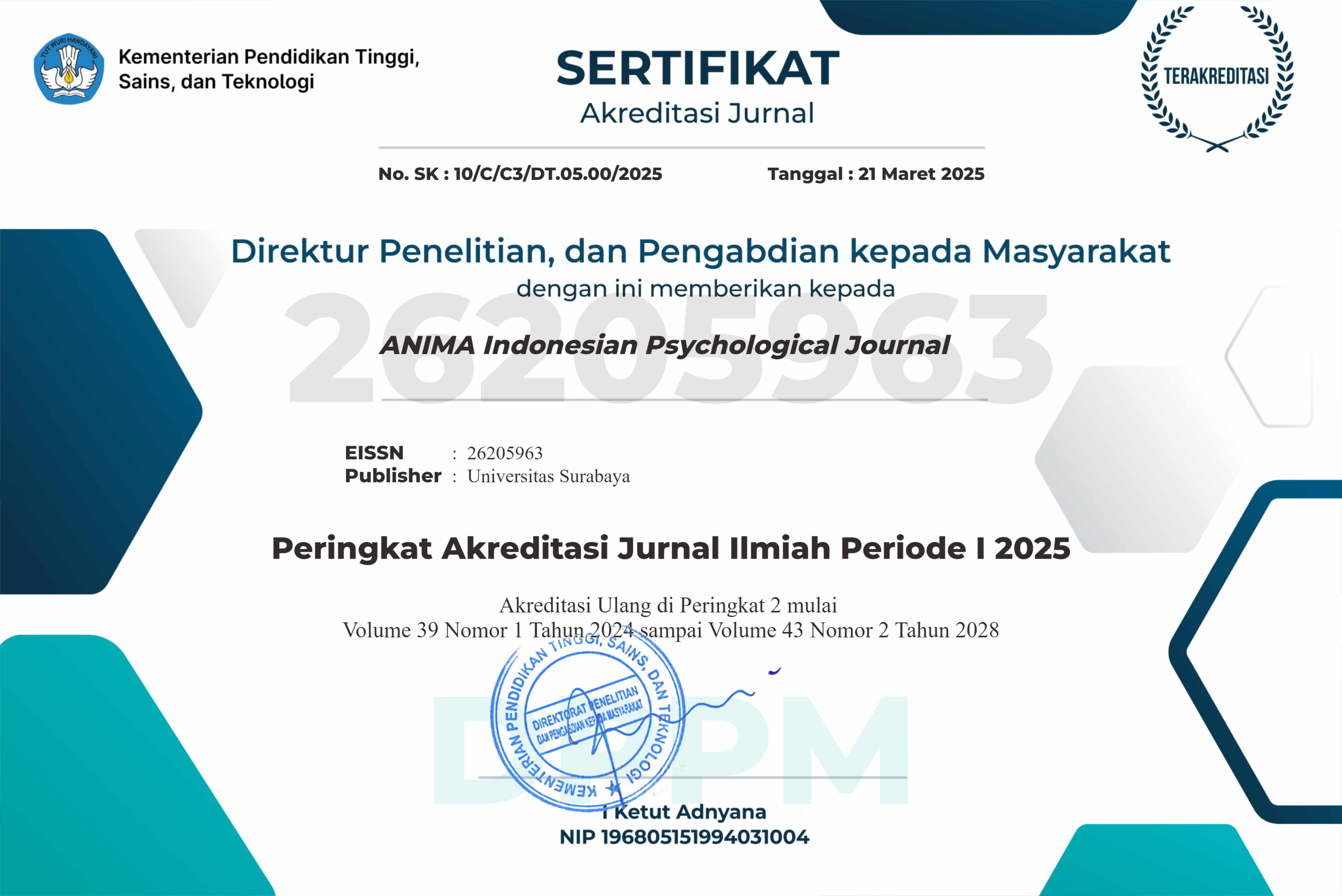Lead, Care, or Lose? Transformational Leadership, Ethical Climate, and the Impact of Physical Work Environment on Turnover Intention Among Generation Z Workers
 Abstract Views:
534 times
Abstract Views:
534 times
 PDF - Full Text Downloads:
217 times
PDF - Full Text Downloads:
217 times
Abstract
Generation Z, which currently dominates the workforce, has high expectations for work-life balance, material rewards, and supportive physical work environment (PWE). This study explores the influence of transformational leadership (TL), caring ethical climate (CEC), and physical work environment (PWE) on turnover intention (TI) among 317 Generation Z workers across various sectors in Indonesia. Study findings reveal that transformational leadership (TL) directly reduces turnover intention (TI; β = - .70; p < .05), though the mediating effect through caring ethical climate (CEC) is not significant; only evident under low physical work environment (PWE) conditions. Results also show that physical work environment (PWE) plays a significant moderating role (β = - .63; p < .05), strengthening the positive impact of caring ethical climate (CEC) in reducing turnover intention (TI). In other words, a conducive physical work environment (PWE) not only enhances comfort, but also supports the creation of an ethical culture that more effectively lowers turnover intention (TI). This highlights that physical factors in the workplace have a substantial impact, both directly and indirectly, on employee retention. This study underscores the importance of transformational leadership (TL) and the management of physical work environment (PWE) in enhancing the loyalty of Generation Z workers, with results providing strategic insights to improve retention through a holistic approach.
Downloads
References
Aliaga, M., & Gunderson, B. (2002). Interactive statistics (2nd ed.). Prentice Hall.
Bass, B. M., & Avolio, B. J. (Eds.). (1994). Improving organizational effectiveness through transformational leadership. SAGE Publications, Inc.. https://psycnet.apa.org/record/1995-97316-000
Bass, B. M., & Riggio, R. E. (2006). Transformational leadership (2nd ed.). Psychology Press. https://doi.org/10.4324/9781410617095
Blau, P. M. (1964). Exchange and power in social life (1st ed.). Routledge. https://doi.org/10.4324/9780203792643
Bothma, C. F. C., & Roodt, G. (2013). The validation of the Turnover Intention Scale. SA Journal of Human Resource Management (SAJHRM), 11(1): a507. https://doi.org/10.4102/sajhrm.v11i1.507
Burns, J. M. (1978). Leadership. Harper & Row. https://psycnet.apa.org/record/1980-03173-000
Carless, S. A., Wearing, A. J., & Mann, L. (2000). A short measure of transformational leadership. Journal of Business and Psychology, 14(3), 389-405. https://doi.org/10.1023/A:1022991115523
Chillakuri, B. (2020). Understanding Generation Z expectations for effective onboarding. Journal of Organizational Change Management, 33(7), 1277-1296. https://doi.org/10.1108/JOCM-02-2020-0058
Ciptaningtyas, A. H., Suyasa, P. T. Y. S., & Wati, L. (2017). The relationships between job embeddedness, person-organization fit, and turnover intention. ANIMA Indonesian Psychological Journal, 33(1), 32-40. https://doi.org/10.24123/aipj.v33i1.1439
Cropanzano, R., & Mitchell, M. S. (2005). Social exchange theory: An interdisciplinary review. Journal of Management, 31(6), 874-900. https://doi.org/10.1177/0149206305279602
Cullen, J. B., Victor, B., & Bronson, J. W. (1993). The Ethical Climate Questionnaire: An assessment of its development and validity. Psychological Reports, 73(2), 667-674. https://doi.org/10.2466/pr0.1993.73.2.667
DeConinck, J. B. (2010). The influence of ethical climate on marketing employees’ job attitudes and behaviors. Journal of Business Research, 63(4), 384-391. https://doi.org/10.1016/j.jbusres.2008.11.009
Deloitte Global. (2022). Striving for balance, advocating for change: The Deloitte Global 2022 Gen Z & Millennial Survey. Deloitte Touche Tohmatsu Limited (DTTL). https://www.deloitte.com/content/dam/insights/articles/2022/glob175227_global-millennial-and-gen-z-survey/Gen-Z-and-Millennial-Survey-2022_Final.pdf
Dimock, M. (2019). Defining generations: Where Millennials end and Generation Z begins. Pew Research Center. https://www.pewresearch.org/short-reads/2019/01/17/where-millennials-end-and-generation-z-begins/
Emerson, R. M. (1976). Social exchange theory. Annual Review of Sociology, 2, 335-362. https://doi.org/10.1146/annurev.so.02.080176.002003
Erdilek Karabay, M., Şener, İ., Elçi, M., & Ensari, Ş. (2019). Analyzing the effect of antecedents of turnover intention according to generations. In M. Özşahin, & T. Hıdırlar (Eds.), New challenges in leadership and technology management, vol. 54. European proceedings of social and behavioural sciences (pp. 578-589). Future Academy. https://doi.org/10.15405/epsbs.2019.01.02.49
Gouldner, A. W. (1960). The norm of reciprocity: A preliminary statement. American Sociological Review, 25(2), 161-178. https://doi.org/10.2307/2092623
Hayes, A. F. (2013). Introduction to mediation, moderation, and conditional process analysis: A regression-based approach. The Guilford Press. https://psycnet.apa.org/record/2013-21121-000
Homans, G. C. (1958). Social behavior as exchange. American Journal of Sociology, 63(6), 597-606. https://doi.org/10.1086/222355
Humaira, S., Aprilia, E. D., Mirza, M., Khatijatusshalihah, K. (2024). Intensi job hopping pada Generasi Y dan Z [Job hopping intention in Generation Y and Z]. Syiah Kuala Psychology Journal, 2(1), 1-10. https://jim.usk.ac.id/Psikologi/article/view/29672
International Labour Organization (ILO). (2016). Workplace stress: A collective challenge. International Labour Organization (ILO) - International Labour Office. https://www.ilo.org/global/topics/safety-and-health-at-work/resources-library/publications/WCMS_466547/lang--en/index.htm%0Ahttp://www.ilo.org/africa/media-centre/news/WCMS_477712/lang--en/index.htm
Kawana, D. (2024). Impact of transformational leadership on employee motivation in Namibia. American Journal of Leadership and Governance (AJLG), 9(3), 1-11. https://doi.org/10.47672/ajlg.2148
Kline, R. B. (2016). Principles and practice of structural equation modeling (4th ed.). The Guilford Press. https://psycnet.apa.org/record/2015-56948-000
Kuzior, A., Kettler, K., & Rabą, Ł. (2022). Great resignation—Ethical, cultural, relational, and personal dimensions of Generation Y and Z employees’ engagement. Sustainability, 14(11): 6764. https://doi.org/10.3390/su14116764
LeBlanc, J. (2025). Engaged Empathy Leadership Model™ (EELM™). Jeff LeBlanc, DBA. https://jeffleblancdba.com/eelm
Marques, T., Crespo, C. F., Pina e Cunha, M., Caçador, M., & Dias, S. S. (2023). Responsible leadership and turnover intentions in health-care professionals: The mediating role of burnout. Leadership in Health Services, 36(4), 562-578. https://doi.org/10.1108/LHS-11-2022-0109
Martin, K. D., & Cullen, J. B. (2006). Continuities and extensions of ethical climate theory: A meta-analytic review. Journal of Business Ethics, 69, 175-194. https://doi.org/10.1007/s10551-006-9084-7
Mas-Manchón, L., Fernández-Cavia, J., Estanyol, E., & Van-Bergen, P. (2024). Differences across generations in the perception of the ethical, social, environmental, and labor responsibilities of the most reputed Spanish organizations. Profesional de La Información [Information Professional], 33(3), 1-14. https://doi.org/10.3145/epi.2024.0302
Masruroh, D., & Himam, F. (2014). The role of emotional intelligence, job satisfaction and transformational leadership toward organizational citizenship behavior of nurses. ANIMA Indonesian Psychological Journal, 29(3), 136-145. https://journal.ubaya.ac.id/index.php/jpa/article/view/4268
McKinsey & Company. (2024). What is Gen Z?. McKinsey & Company. https://www.mckinsey.com/featured-insights/mckinsey-explainers/what-is-gen-z
Mulki, J. P., Jaramillo J. F., & Locander, W. B. (2008). Effect of ethical climate on turnover intention: Linking attitudinal- and stress theory. Journal of Business Ethics, 78(4), 559-574. https://doi.org/10.1007/s10551-007-9368-6
Nguyen Ngoc, T., Viet Dung, M., Rowley, C., & Pejić Bach, M. (2022). Generation Z job seekers’ expectations and their job pursuit intention: Evidence from transition and emerging economy. International Journal of Engineering Business Management, 14, 1-13. https://doi.org/10.1177/18479790221112548
Nunnally, J. C., & Bernstein, I. H. (1994). Psychometric theory. McGraw-Hill.
Ozyer, K., Aydin, E. M., Azizoglu, O., & Erenler, E. (2010). A study of the relationship between ethical climate and turnover intention in Turkish context. Journal of Management and World Business Research (JOMAWBR), 7(1), 1-12. https://www.academyofworldbusiness.com/wp/jomawbr-v7-n1-2010/
Parboteeah, K. P., Weiss, M., & Hoegl, M. (2024). Ethical climates across national contexts: A meta-analytical investigation. Journal of Business Ethics, 189(3), 573-590. https://doi.org/10.1007/s10551-023-05387-z
Petriglieri, J. L. (2011). Under threat: Responses to and the consequences of threats to individuals’ identities. Academy of Management Review, 36(4), 641-662. https://doi.org/10.5465/amr.2009.0087
Rindu, R., Lukman, S., Hardisman, H., Hafizurrachman, M., & Bachtiar, A. (2020). The relationship between transformational leadership, organizational commitment, work stress, and turnover intentions of nurse at private hospital in Indonesia. Open Access Macedonian Journal of Medical Sciences, 8(E), 551-557. https://doi.org/10.3889/oamjms.2020.4425
Roodt, G., & Bothma, F. C. (1997). Die koste van vrywillige, beheerbare arbeidsomset [The cost of voluntary, controlable labour turnover]. Journal of Industrial Psychology, 23(1), 26-30. https://doi.org/10.4102/sajip.v23i1.619
Saeed, F., & Jun, Y. (2022). The impact of transformational leadership on employee turnover intention: The mediating and moderating role of affective organizational commitment and job embeddedness. International Journal of Management, Accounting and Economics, 9(5), 247-267. https://doi.org/10.5281/zenodo.6762232
Saǧnak, M. (2010). The relationship between transformational school leadership and ethical climate. Kuram ve Uygulamada Eğitim Bilimleri (KUYEB) [Educational Sciences: Theory & Practice], 10(2), 1135-1152. https://files.eric.ed.gov/fulltext/EJ889202.pdf
Sander, E. (Libby) J., Caza, A., & Jordan, P. J. (2019). Psychological perceptions matter: Developing the reactions to the Physical Work Environment Scale. Building and Environment, 148, 338-347. https://doi.org/10.1016/j.buildenv.2018.11.020
Sazili, S., Ju’im, J., Indarti, S., & Efendi, R. (2022). Turnover intention influenced by work environment and job satisfaction. International Journal of Social Science Research and Review, 5(6), 102-108. https://doi.org/10.47814/ijssrr.v5i6.291
Schroth, H. (2019). Are you ready for Gen Z in the workplace?. California Management Review, 61(3), 5-18. https://doi.org/10.1177/0008125619841006
Schwepker, C. H., Jr. (2001). Ethical climate’s relationship to job satisfaction, organizational commitment, and turnover intention in the salesforce. Journal of Business Research, 54(1), 39-52. https://doi.org/10.1016/S0148-2963(00)00125-9
Simha, A., & Cullen, J. B. (2012). Ethical climates and their effects on organizational outcomes: Implications from the past and prophecies for the future. Academy of Management Perspectives, 26(4), 20-34. https://doi.org/10.5465/amp.2011.0156
Siregar, L. D., Farla, W., & Herlinda, S. (2023). The Generation Z phenomenon and its implications in the workforce. Jurnal Ekonomi, 12(4), 533-540. https://ejournal.seaninstitute.or.id/index.php/Ekonomi/article/view/2898
Sylvyani, N. R., & Ramli, A. H. (2023). Transformational leadership, knowledge sharing dan organizational commitment terhadap job satisfaction [Transformational leadership, knowledge sharing, and organization commitment on job satisfaction]. Jurnal Ilmiah Manajemen Kesatuan, 11(2), 339-352. https://doi.org/10.37641/jimkes.v11i2.2001
Tett, R. P., & Meyer, J. P. (1993). Job satisfaction, organizational commitment, turnover intention, and turnover: Path analyses based on meta-analytic findings. Personnel Psychology, 46(2), 259-293. https://doi.org/10.1111/j.1744-6570.1993.tb00874.x
Treviño, L. K., Butterfield, K. D., & McCabe, D. L. (1998). The ethical context in organizations: Influences on employee attitudes and behaviors. Business Ethics Quarterly, 8(3), 447-476. https://doi.org/10.5840/10.2307/3857431
Victor, B., & Cullen, J. B. (1988). The organizational bases of ethical work climates. Administrative Science Quarterly, 33(1), 101-125. https://doi.org/10.2307/2392857
Vu, T. D., Nguyen, H. V., Vu, P. T., Tran, T. H. H., Nguyen, H. N., & Ngo, T. S. (2023). Survey data of Gen Z customer behaviour using food delivery applications in Vietnam. Data in Brief, 51: 109779. https://doi.org/10.1016/j.dib.2023.109779
Wiliyanto, I. T., Sudiarditha, I. K., & Yohana, C. (2020). Influence of work environment toward turnover intention with motivation and job satisfaction as intervening variables in PT. TSA. International Journal on Advanced Science, Education, and Religion (IJoASER), 3(1), 11-21. https://doi.org/10.33648/ijoaser.v3i1.42
Xiong, B., Wu, X., & Sui, Q. (2023). The impact of transformational leadership on the turnover intention of the new generation of knowledgeable employees: A moderated mediation model. Frontiers in Psychology, 13: 1090987. https://doi.org/10.3389/fpsyg.2022.1090987
Yücel, İ. (2021). Transformational leadership and turnover intentions: The mediating role of employee performance during the COVID-19 pandemic. Administrative Sciences, 11(3): 81. https://doi.org/10.3390/admsci11030081

This work is licensed under a Creative Commons Attribution-NonCommercial-ShareAlike 4.0 International License.

This work is licensed under a Creative Commons Attribution-NonCommercial-ShareAlike 4.0 International License.
Articles published in ANIMA are licensed under a Creative Commons Attribution-NonCommercial-ShareAlike 4.0 International license. You are free to copy, transform, or redistribute articles for any lawful, non-commercial purpose in any medium, provided you give appropriate credit to ANIMA and the original Author(s), link to the license, indicate if changes were made, and redistribute any derivative work under the same license.
Copyright on articles is retained by the respective Author(s), without restrictions. A non-exclusive license is granted to ANIMA to publish the article and identify itself as its original publisher, along with the commercial right to include the article in a hardcopy issue for sale to libraries and individuals.
By publishing in ANIMA, Author(s) grant any third party the right to use their article to the extent provided by the Creative Commons Attribution-NonCommercial-ShareAlike 4.0 International license.

 DOI:
DOI:



